Greetings!
We had a good class this week and covered a lot of information. Writing a research paper is a mix of learning and doing. Students learn to fine-tune writing skills, to develop ideas about topics, to practice efficient research skills, and to become proficient in citations and MLA formatting. Then, they take what they've learned and put it into practice until they realize they need to learn some more. Throughout this semester, I hope to keep a good flow of learning and doing.
We began the class time by writing for 3 minutes about the topics they have been thinking about. Firstly, I wanted them to write everything they knew about their topics. If they ran out of information, they could begin writing questions about their topics. When we finished this, I asked them to talk with their classmates about their topics in order to get more perspectives about their topics.
Coming up with a good topic and brainstorming ideas can be really challenging. It's important that students are excited about their topic so that they can maintain their interest throughout the semester. It should also be a topic that will provide a blend of their own ideas and researched information. We considered these questions:
"What do I think?"
"What do the experts say?"
"What do I think about what the experts said?"
"What support/evidence/background information do I need?"
Using the topic of raising bilingual children, as a class we brainstormed possible leading questions that we might use to help direct our research. Many times, these leading questions help students to also come up with subtopics.
We went through Steps 7 - 10 of the 30 Steps to a Research Paper. I briefly covered the primary points, and the students should read it more carefully as part of their homework. One of the topics we covered a little more in-depth was the importance of writing effective thesis statements. (They got a handout the focused on this.) A clear thesis statement controls the direction of a good paper.
For next week, students are to write a short 1-page paper titled, "Why I'm Interested" about their interest in their topics. As they plan their papers, they should consider these questions:
-- How did you initially learn about this topic?
-- How much do you already know about this topic?
-- On a scale of 1 to 10, how passionate are you about this area?
-- Who else do you think would be interested in this information?
-- How is this information important?
-- What are your opinions related to this subject?
-- Do you have personal experience connected to this material?
-- And so on …..
Assignments for Next Week:
-- Review Sections 7 - 10
-- "Why I'm Interested" paper
-- Types of Sentences (choose 2 sides)
Links for this Week
Class Notes
Have a great weekend!
Mrs. Prichard

